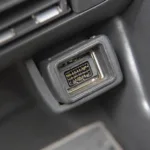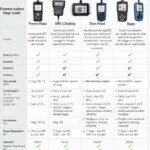The check engine light is a dreaded sight for any driver. What does it mean when that ominous little symbol illuminates your dashboard? In most cases, it signals a problem with your vehicle’s emissions system, which is monitored by the onboard diagnostics (OBD2) system. Understanding “check engine obd2” codes is essential for maintaining your car and preventing costly repairs.
What Does Check Engine OBD2 Mean?
The OBD2 system is a standardized system that allows external devices, like OBD2 scanners, to communicate with your car’s computer. It continuously monitors various sensors and components related to emissions and engine performance. When a problem is detected, the system stores a diagnostic trouble code (DTC) and triggers the check engine light. “Check engine obd2” essentially means using an OBD2 scanner to retrieve and interpret these codes. check engine obd2 code can help you pinpoint the issue.
Why is My Check Engine OBD2 Light On?
There are numerous reasons why your check engine light might be on, ranging from a loose gas cap to a more serious issue like a faulty catalytic converter. obd2 catalytic converter check engine light addresses this specific problem. Some common causes include:
- Loose or damaged gas cap: This can cause fuel vapors to escape, triggering the evaporative emission system monitor.
- Faulty oxygen sensor: Oxygen sensors measure the amount of oxygen in the exhaust gases and help regulate the air-fuel mixture.
- Failing catalytic converter: The catalytic converter converts harmful pollutants in exhaust gases into less harmful substances.
- Spark plug or ignition coil problems: These issues can affect engine performance and emissions.
- Mass airflow sensor malfunction: The mass airflow sensor measures the amount of air entering the engine, which is crucial for proper fuel delivery.
How to Check Engine OBD2 Codes
Retrieving the check engine obd2 codes requires an OBD2 scanner. These devices are readily available at auto parts stores and online. Here’s a simple guide:
- Locate the OBD2 port: Usually located under the dashboard on the driver’s side.
- Plug the OBD2 scanner into the port.
- Turn the ignition key to the “on” position (do not start the engine).
- Follow the instructions on the scanner to read the codes.
Interpreting Check Engine OBD2 Codes
Once you’ve retrieved the codes, you’ll need to interpret them. obd2 check engine codes provides valuable insights into different code definitions. Each code corresponds to a specific problem. You can find code definitions online or in repair manuals. Remember, codes don’t always pinpoint the exact problem; they indicate the area where the problem exists. Further diagnosis might be required.
how to check engine obd2 codes on jeep grand cherokee provides specific guidance for Jeep Grand Cherokee owners.
What to Do After Checking Engine OBD2 Codes
After retrieving and interpreting the codes, you have several options:
- DIY repair: If you’re mechanically inclined, you may be able to fix the problem yourself.
- Consult a professional mechanic: For complex issues, it’s best to consult a qualified mechanic. obd2 mil on discusses the malfunction indicator lamp and its significance.
“A check engine light doesn’t always mean an immediate crisis, but it shouldn’t be ignored. Early diagnosis can prevent small problems from becoming expensive repairs.” – David Miller, Automotive Engineer
“Regularly checking your vehicle’s OBD2 system can help you stay on top of potential issues and maintain your car’s health.” – Susan Carter, Certified Mechanic
In conclusion, understanding the “check engine obd2” light and using a scanner to retrieve and interpret codes is crucial for car maintenance. Don’t panic when the light comes on. Instead, take action to diagnose and address the issue promptly.
Need assistance? Contact us via WhatsApp: +1(641)206-8880, Email: [email protected] or visit our office at 789 Elm Street, San Francisco, CA 94102, USA. Our customer support team is available 24/7.

